Improved Biomagnetic Signal-To-Noise Ratio and Source Localization Using Optically Pumped Magnetometers with Synthetic Gradiometers
Abstract
1. Introduction
2. Materials and Methods
2.1. MEG Recordings
2.2. Synthetic Gradiometers (SGs)
2.3. Noise Reduction
2.4. Phantom
2.5. Human Participants
2.6. Signal-To-Noise Ratio (SNR)
2.7. Data Analysis
2.8. Source Localization
2.9. Statistical Analysis
3. Results
3.1. Empty Room Data
3.2. Phantom Data
3.3. Human Participant’s Data
4. Discussion
5. Conclusions
Author Contributions
Funding
Institutional Review Board Statement
Informed Consent Statement
Data Availability Statement
Acknowledgments
Conflicts of Interest
References
- Tenney, J.R.; Kadis, D.S.; Agler, W.; Rozhkov, L.; Altaye, M.; Xiang, J.; Vannest, J.; Glauser, T.A. Ictal connectivity in childhood absence epilepsy: Associations with outcome. Epilepsia 2018, 59, 971–981. [Google Scholar] [CrossRef] [PubMed]
- Leiken, K.; Xiang, J.; Zhang, F.; Shi, J.; Tang, L.; Liu, H.; Wang, X. Magnetoencephalography detection of high-frequency oscillations in the developing brain. Front. Hum. Neurosci. 2014, 8, 969. [Google Scholar] [CrossRef]
- Bagic, A.I.; Knowlton, R.C.; Rose, D.F.; Ebersole, J.S. American Clinical Magnetoencephalography Society Clinical Practice Guideline 3: MEG-EEG reporting. J. Clin. Neurophysiol. Off. Publ. Am. Electroencephalogr. Soc. 2011, 28, 362–363. [Google Scholar]
- Burgess, R.C.; Funke, M.E.; Bowyer, S.M.; Lewine, J.D.; Kirsch, H.E.; Bagic, A.I. American Clinical Magnetoencephalography Society Clinical Practice Guideline 2: Presurgical functional brain mapping using magnetic evoked fields. J. Clin. Neurophysiol. Off. Publ. Am. Electroencephalogr. Soc. 2011, 28, 355–361. [Google Scholar] [CrossRef] [PubMed]
- Hari, R.; Salmelin, R. Magnetoencephalography: From SQUIDs to neuroscience. Neuroimage 20th anniversary special edition. NeuroImage 2012, 61, 386–396. [Google Scholar] [CrossRef]
- Seymour, R.A.; Alexander, N.; Mellor, S.; O’Neill, G.C.; Tierney, T.M.; Barnes, G.R.; Maguire, E.A. Using OPMs to measure neural activity in standing, mobile participants. NeuroImage 2021, 244, 118604. [Google Scholar] [CrossRef]
- Iivanainen, J.; Zetter, R.; Gron, M.; Hakkarainen, K.; Parkkonen, L. On-scalp MEG system utilizing an actively shielded array of optically-pumped magnetometers. NeuroImage 2019, 194, 244–258. [Google Scholar] [CrossRef]
- Tierney, T.M.; Holmes, N.; Mellor, S.; Lopez, J.D.; Roberts, G.; Hill, R.M.; Boto, E.; Leggett, J.; Shah, V.; Brookes, M.J.; et al. Optically pumped magnetometers: From quantum origins to multi-channel magnetoencephalography. NeuroImage 2019, 199, 598–608. [Google Scholar] [CrossRef]
- Boto, E.; Seedat, Z.A.; Holmes, N.; Leggett, J.; Hill, R.M.; Roberts, G.; Shah, V.; Fromhold, T.M.; Mullinger, K.J.; Tierney, T.M.; et al. Wearable neuroimaging: Combining and contrasting magnetoencephalography and electroencephalography. NeuroImage 2019, 201, 116099. [Google Scholar] [CrossRef]
- Boto, E.; Holmes, N.; Leggett, J.; Roberts, G.; Shah, V.; Meyer, S.S.; Munoz, L.D.; Mullinger, K.J.; Tierney, T.M.; Bestmann, S.; et al. Moving magnetoencephalography towards real-world applications with a wearable system. Nature 2018, 555, 657–661. [Google Scholar] [CrossRef]
- Tierney, T.M.; Levy, A.; Barry, D.N.; Meyer, S.S.; Shigihara, Y.; Everatt, M.; Mellor, S.; Lopez, J.D.; Bestmann, S.; Holmes, N.; et al. Mouth magnetoencephalography: A unique perspective on the human hippocampus. NeuroImage 2021, 225, 117443. [Google Scholar] [CrossRef] [PubMed]
- Marhl, U.; Jodko-Wladzinska, A.; Bruhl, R.; Sander, T.; Jazbinsek, V. Transforming and comparing data between standard SQUID and OPM-MEG systems. PLoS ONE 2022, 17, e0262669. [Google Scholar] [CrossRef] [PubMed]
- Hill, R.M.; Boto, E.; Rea, M.; Holmes, N.; Leggett, J.; Coles, L.A.; Papastavrou, M.; Everton, S.K.; Hunt, B.A.E.; Sims, D.; et al. Multi-channel whole-head OPM-MEG: Helmet design and a comparison with a conventional system. NeuroImage 2020, 219, 116995. [Google Scholar] [CrossRef] [PubMed]
- Nardelli, N.V.; Perry, A.R.; Krzyzewski, S.P.; Knappe, S.A. A conformal array of microfabricated optically-pumped first-order gradiometers for magnetoencephalography. EPJ Quantum Technol. 2020, 7, 11. [Google Scholar] [CrossRef]
- Sheng, D.; Perry, A.R.; Krzyzewski, S.P.; Geller, S.; Kitching, J.; Knappe, S. A microfabricated optically-pumped magnetic gradiometer. Appl. Phys. Lett. 2017, 110, 031106. [Google Scholar] [CrossRef]
- Xiang, J.; Korman, A.; Samarasinghe, K.M.; Wang, X.; Zhang, F.; Qiao, H.; Sun, B.; Wang, F.; Fan, H.H.; Thompson, E.A. Volumetric imaging of brain activity with spatial-frequency decoding of neuromagnetic signals. J. Neurosci. Methods 2015, 239, 114–128. [Google Scholar] [CrossRef]
- Xiang, J.; Luo, Q.; Kotecha, R.; Korman, A.; Zhang, F.; Luo, H.; Fujiwara, H.; Hemasilpin, N.; Rose, D.F. Accumulated source imaging of brain activity with both low and high-frequency neuromagnetic signals. Front. Neuroinform. 2014, 8, 57. [Google Scholar] [CrossRef]
- Rhodes, N.; Rea, M.; Boto, E.; Rier, L.; Shah, V.; Hill, R.M.; Osborne, J.; Doyle, C.; Holmes, N.; Coleman, S.C.; et al. Measurement of Frontal Midline Theta Oscillations using OPM-MEG. NeuroImage 2023, 271, 120024. [Google Scholar] [CrossRef]
- Hillebrand, A.; Holmes, N.; Sijsma, N.; O’Neill, G.C.; Tierney, T.M.; Liberton, N.; Stam, A.H.; van Klink, N.; Stam, C.J.; Bowtell, R.; et al. Non-invasive measurements of ictal and interictal epileptiform activity using optically pumped magnetometers. Sci. Rep. 2023, 13, 4623. [Google Scholar] [CrossRef]
- Feys, O.; Corvilain, P.; Aeby, A.; Sculier, C.; Holmes, N.; Brookes, M.; Goldman, S.; Wens, V.; De Tiege, X. On-Scalp Optically Pumped Magnetometers versus Cryogenic Magnetoencephalography for Diagnostic Evaluation of Epilepsy in School-aged Children. Radiology 2022, 304, 429–434. [Google Scholar] [CrossRef]
- Shah, V.K.; Wakai, R.T. A compact, high performance atomic magnetometer for biomedical applications. Phys. Med. Biol. 2013, 58, 8153–8161. [Google Scholar] [CrossRef] [PubMed]
- Vrba, J.; Robinson, S.E. Signal processing in magnetoencephalography. Methods 2001, 25, 249–271. [Google Scholar] [CrossRef] [PubMed]
- Alexopoulos, E.C. Introduction to multivariate regression analysis. Hippokratia 2010, 14, 23. [Google Scholar] [PubMed]
- Sun, L.; Hamalainen, M.S.; Okada, Y. Noise cancellation for a whole-head magnetometer-based MEG system in hospital environment. Biomed. Phys. Eng. Express 2018, 4, 055014. [Google Scholar] [CrossRef]
- Ramirez, R.R.; Kopell, B.H.; Butson, C.R.; Hiner, B.C.; Baillet, S. Spectral signal space projection algorithm for frequency domain MEG and EEG denoising, whitening, and source imaging. NeuroImage 2011, 56, 78–92. [Google Scholar] [CrossRef] [PubMed]
- Sekihara, K.; Kawabata, Y.; Ushio, S.; Sumiya, S.; Kawabata, S.; Adachi, Y.; Nagarajan, S.S. Dual signal subspace projection (DSSP): A novel algorithm for removing large interference in biomagnetic measurements. J. Neural Eng. 2016, 13, 036007. [Google Scholar] [CrossRef]
- Schlink, B.R.; Ferris, D.P. A Lower Limb Phantom for Simulation and Assessment of Electromyography Technology. IEEE Trans. Neural Syst. Rehabil. Eng. 2019, 27, 2378–2385. [Google Scholar] [CrossRef] [PubMed]
- Oliveira, A.S.; Schlink, B.R.; Hairston, W.D.; Konig, P.; Ferris, D.P. Induction and separation of motion artifacts in EEG data using a mobile phantom head device. J. Neural Eng. 2016, 13, 036014. [Google Scholar] [CrossRef]
- Wang, X.; Xiang, J.; Wang, Y.; Pardos, M.; Meng, L.; Huo, X.; Korostenskaja, M.; Powers, S.W.; Kabbouche, M.A.; Hershey, A.D. Identification of abnormal neuromagnetic signatures in the motor cortex of adolescent migraine. Headache 2010, 50, 1005–1016. [Google Scholar] [CrossRef]
- Larson, E.; Taulu, S. Reducing Sensor Noise in MEG and EEG Recordings Using Oversampled Temporal Projection. IEEE Trans. Bio-Med. Eng. 2018, 65, 1002–1013. [Google Scholar] [CrossRef]
- Xiang, J.; Tong, H.; Jiang, Y.; Barnes-Davis, M.E. Spatial and Frequency Specific Artifact Reduction in Optically Pumped Magnetometer Recordings. J. Integr. Neurosci. 2022, 21, 145. [Google Scholar] [CrossRef] [PubMed]
- Boon, L.I.; Tewarie, P.; Berendse, H.W.; Stam, C.J.; Hillebrand, A. Longitudinal consistency of source-space spectral power and functional connectivity using different magnetoencephalography recording systems. Sci. Rep. 2021, 11, 16336. [Google Scholar] [CrossRef] [PubMed]
- Giordano, M.; Maddalena, L.; Manzo, M.; Guarracino, M.R. Adversarial attacks on graph-level embedding methods: A case study. Ann. Math. Artif. Intell. 2022, in press. [CrossRef]
- Kominis, I.; Kornack, T.; Allred, J.; Romalis, M.V. A subfemtotesla multichannel atomic magnetometer. Nature 2003, 422, 596–599. [Google Scholar] [CrossRef] [PubMed]
- Allred, J.; Lyman, R.; Kornack, T.; Romalis, M.V. High-sensitivity atomic magnetometer unaffected by spin-exchange relaxation. Phys. Rev. Lett. 2002, 89, 130801. [Google Scholar] [CrossRef] [PubMed]
- Krzyzewski, S.P.; Perry, A.R.; Gerginov, V.; Knappe, S. Characterization of noise sources in a microfabricated single-beam zero-field optically-pumped magnetometer. J. Appl. Phys. 2019, 126, 044504. [Google Scholar] [CrossRef] [PubMed]
- Liu, L.S.; Lu, Y.T.; Zhuang, X.; Zhang, Q.Y.; Fang, G.Y. Noise Analysis in Pre-Amplifier Circuits Associated to Highly Sensitive Optically-Pumped Magnetometers for Geomagnetic Applications. Appl. Sci. 2020, 10, 7172. [Google Scholar] [CrossRef]
- Groeger, S.; Bison, G.; Weis, A. Design and Performance of Laser-Pumped Cs-Magnetometers for the Planned UCN EDM Experiment at PSI. J. Res. Natl. Inst. Stand. Technol. 2005, 110, 179–183. [Google Scholar] [CrossRef]
- Xiang, J.; Degrauw, X.; Korman, A.M.; Allen, J.R.; O’Brien, H.L.; Kabbouche, M.A.; Powers, S.W.; Hershey, A.D. Neuromagnetic abnormality of motor cortical activation and phases of headache attacks in childhood migraine. PLoS ONE 2013, 8, e83669. [Google Scholar] [CrossRef]
- Guo, X.; Xiang, J.; Wang, Y.; O’Brien, H.; Kabbouche, M.; Horn, P.; Powers, S.W.; Hershey, A.D. Aberrant neuromagnetic activation in the motor cortex in children with acute migraine: A magnetoencephalography study. PLoS ONE 2012, 7, e50095. [Google Scholar] [CrossRef]
- Xiang, J.; Liu, Y.; Wang, Y.; Kirtman, E.G.; Kotecha, R.; Chen, Y.; Huo, X.; Fujiwara, H.; Hemasilpin, N.; Lee, K.; et al. Frequency and spatial characteristics of high-frequency neuromagnetic signals in childhood epilepsy. Epileptic Disord. Int. Epilepsy J. Videotape 2009, 11, 113–125. [Google Scholar] [CrossRef]
- Oishi, M.; Otsubo, H.; Iida, K.; Suyama, Y.; Ochi, A.; Weiss, S.K.; Xiang, J.; Gaetz, W.; Cheyne, D.; Chuang, S.H.; et al. Preoperative simulation of intracerebral epileptiform discharges: Synthetic aperture magnetometry virtual sensor analysis of interictal magnetoencephalography data. J. Neurosurg. 2006, 105, 41–49. [Google Scholar] [CrossRef] [PubMed]
- Jodko-Wladzinska, A.; Wildner, K.; Palko, T.; Wladzinski, M. Compensation System for Biomagnetic Measurements with Optically Pumped Magnetometers inside a Magnetically Shielded Room. Sensors 2020, 20, 4563. [Google Scholar] [CrossRef] [PubMed]
- Nardelli, N.V.; Krzyzewski, S.P.; Knappe, S.A. Reducing crosstalk in optically-pumped magnetometer arrays. Phys. Med. Biol. 2019, 64, 21NT03. [Google Scholar] [CrossRef] [PubMed]
- Holmes, N.; Tierney, T.M.; Leggett, J.; Boto, E.; Mellor, S.; Roberts, G.; Hill, R.M.; Shah, V.; Barnes, G.R.; Brookes, M.J.; et al. Balanced, bi-planar magnetic field and field gradient coils for field compensation in wearable magnetoencephalography. Sci. Rep. 2019, 9, 14196. [Google Scholar] [CrossRef]
- Sheng, D.; Li, S.; Dural, N.; Romalis, M.V. Subfemtotesla scalar atomic magnetometry using multipass cells. Phys. Rev. Lett. 2013, 110, 160802. [Google Scholar] [CrossRef]
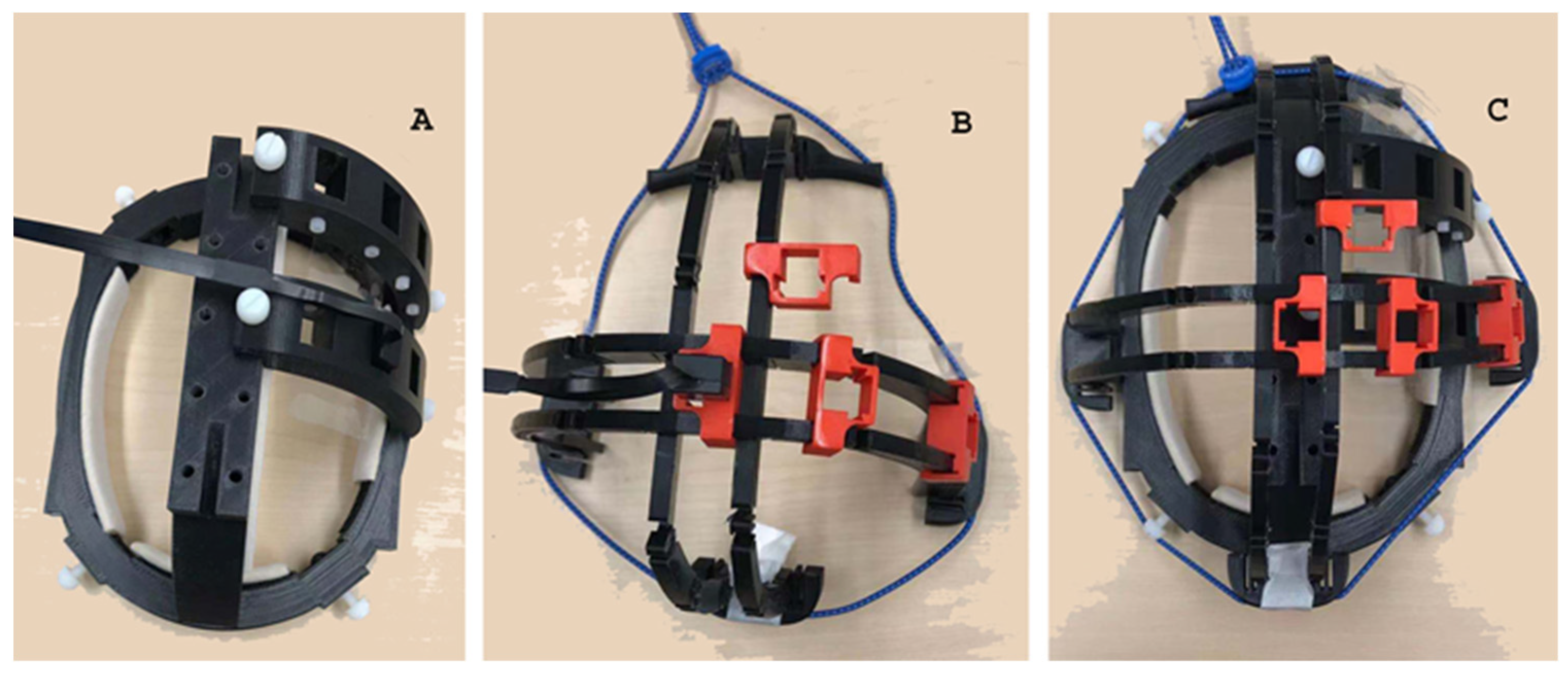
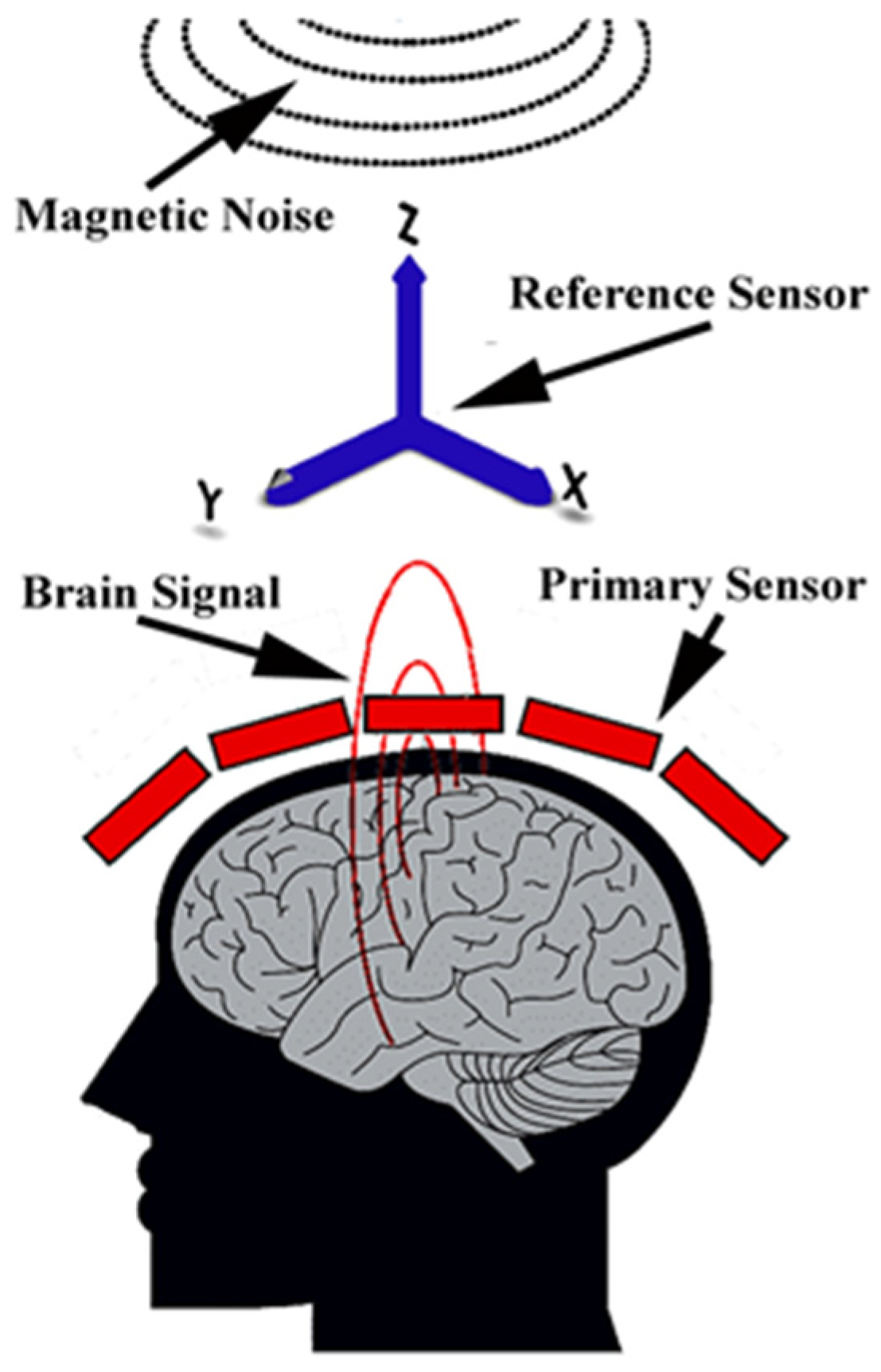
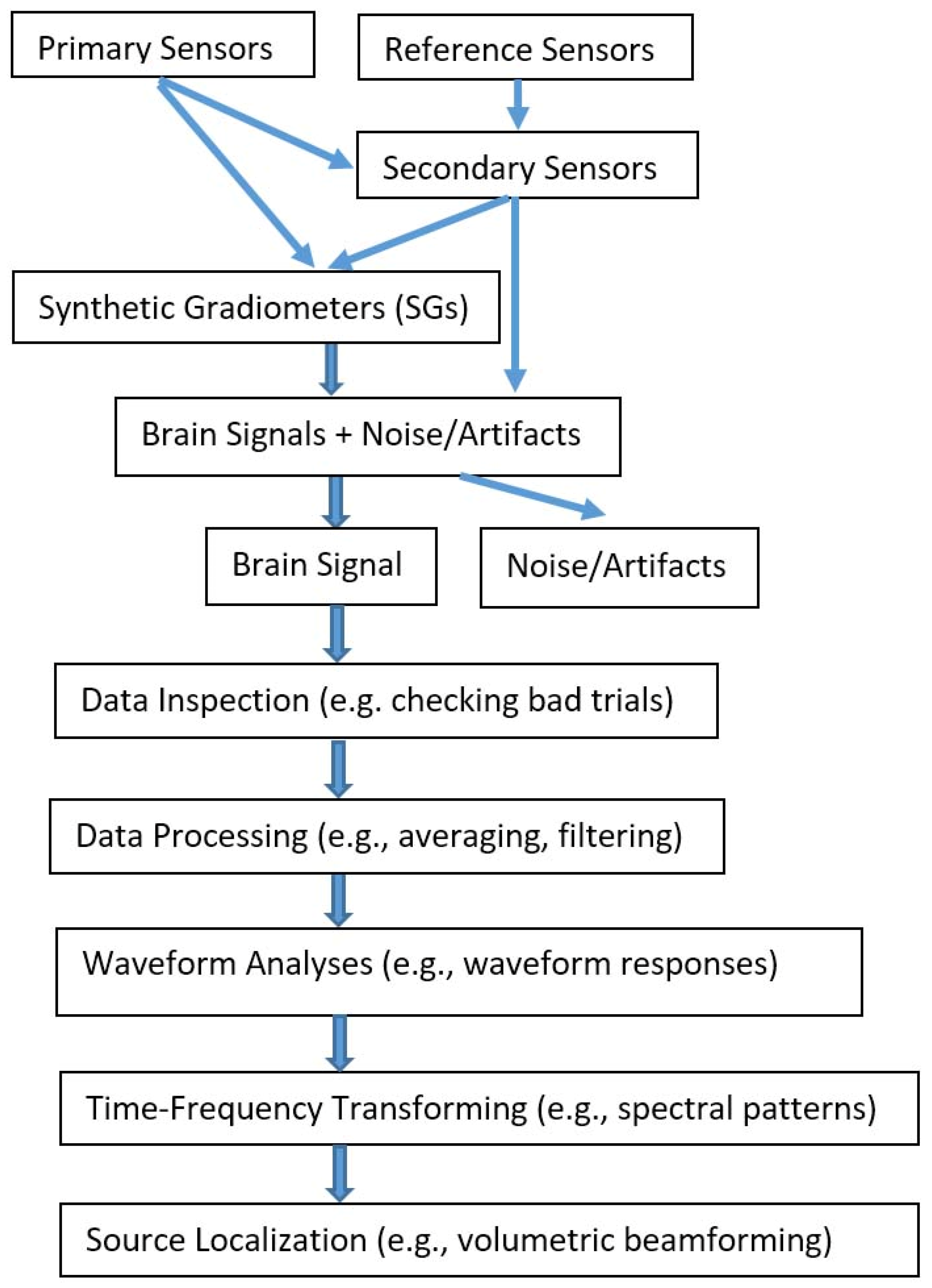

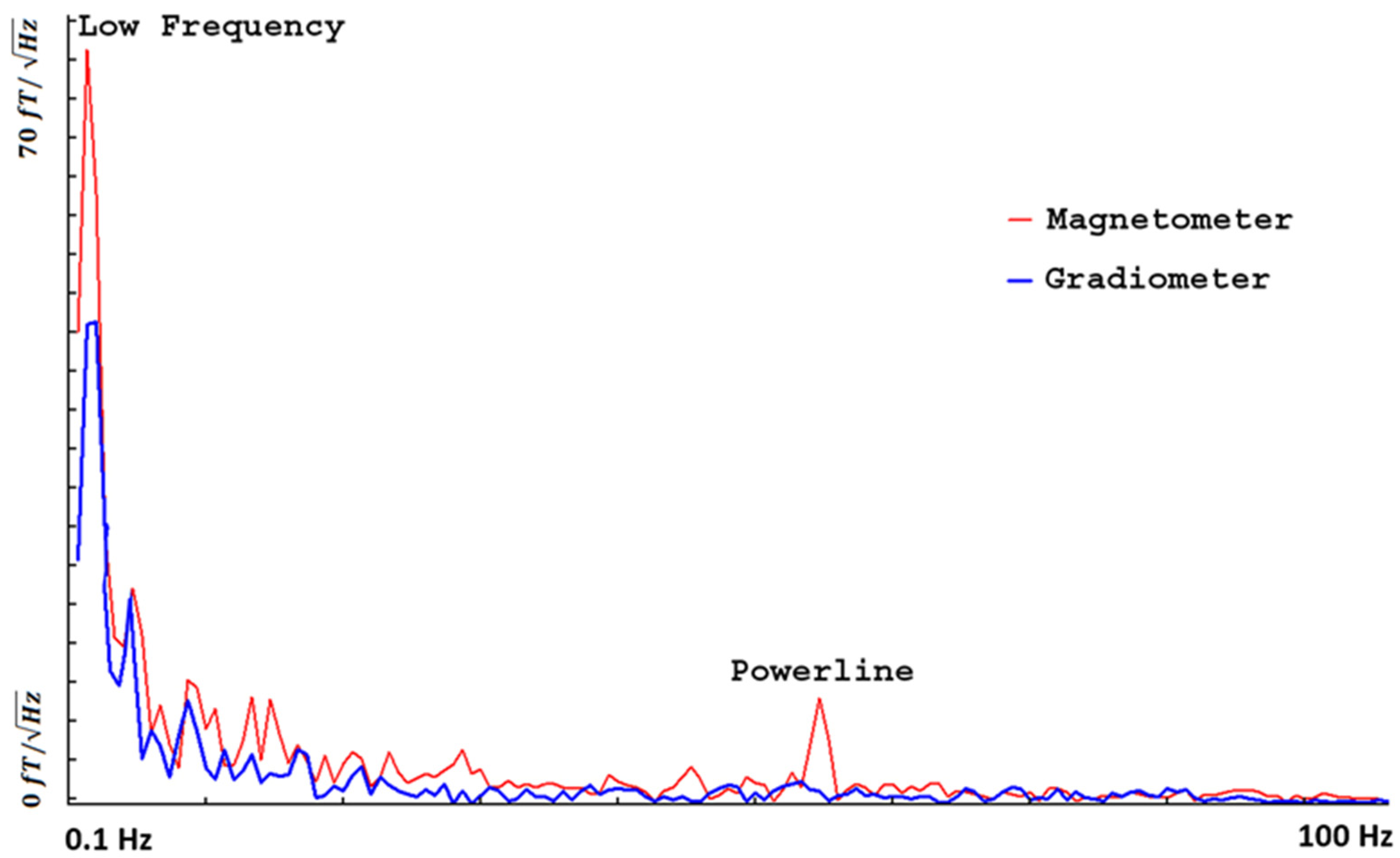
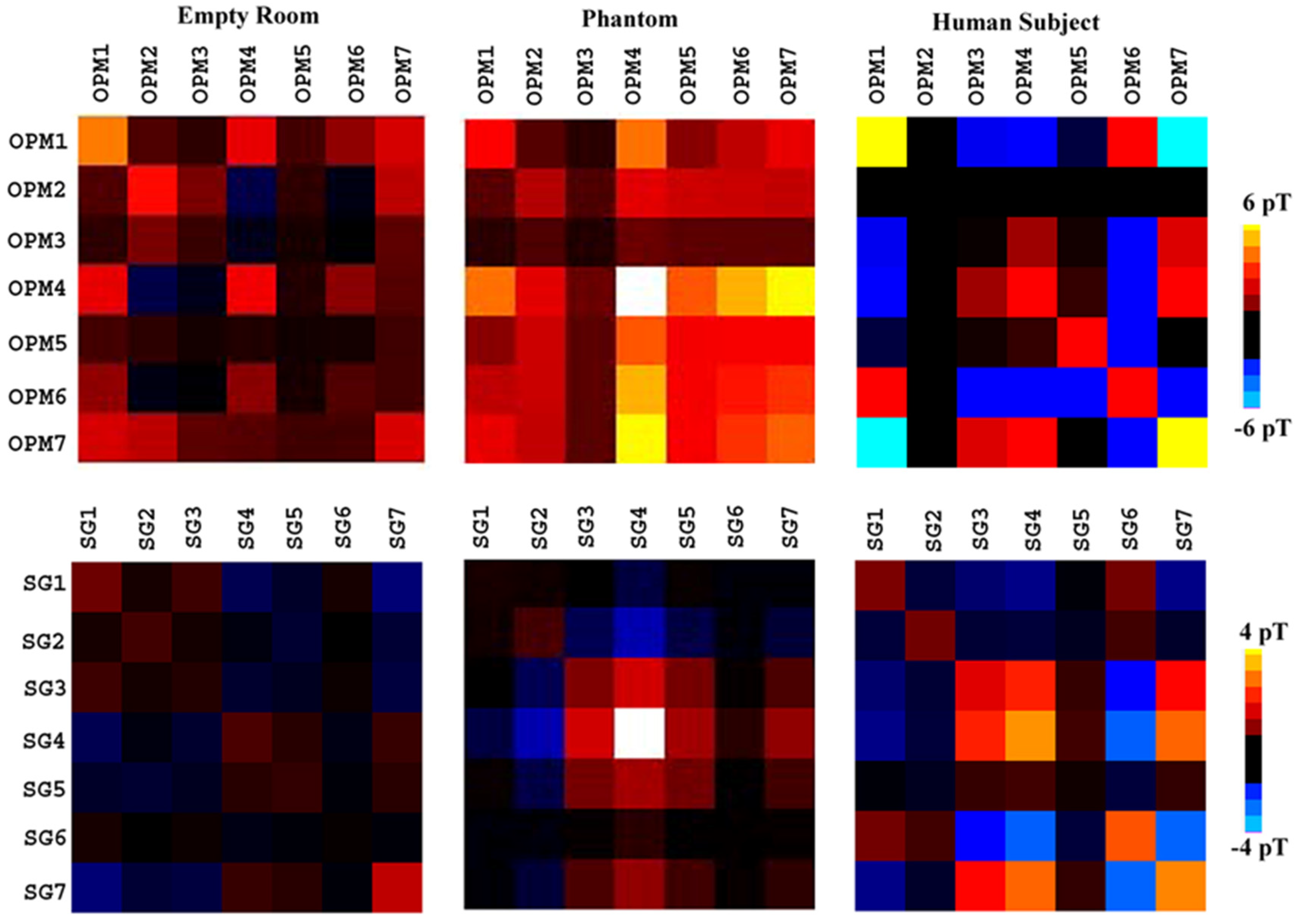
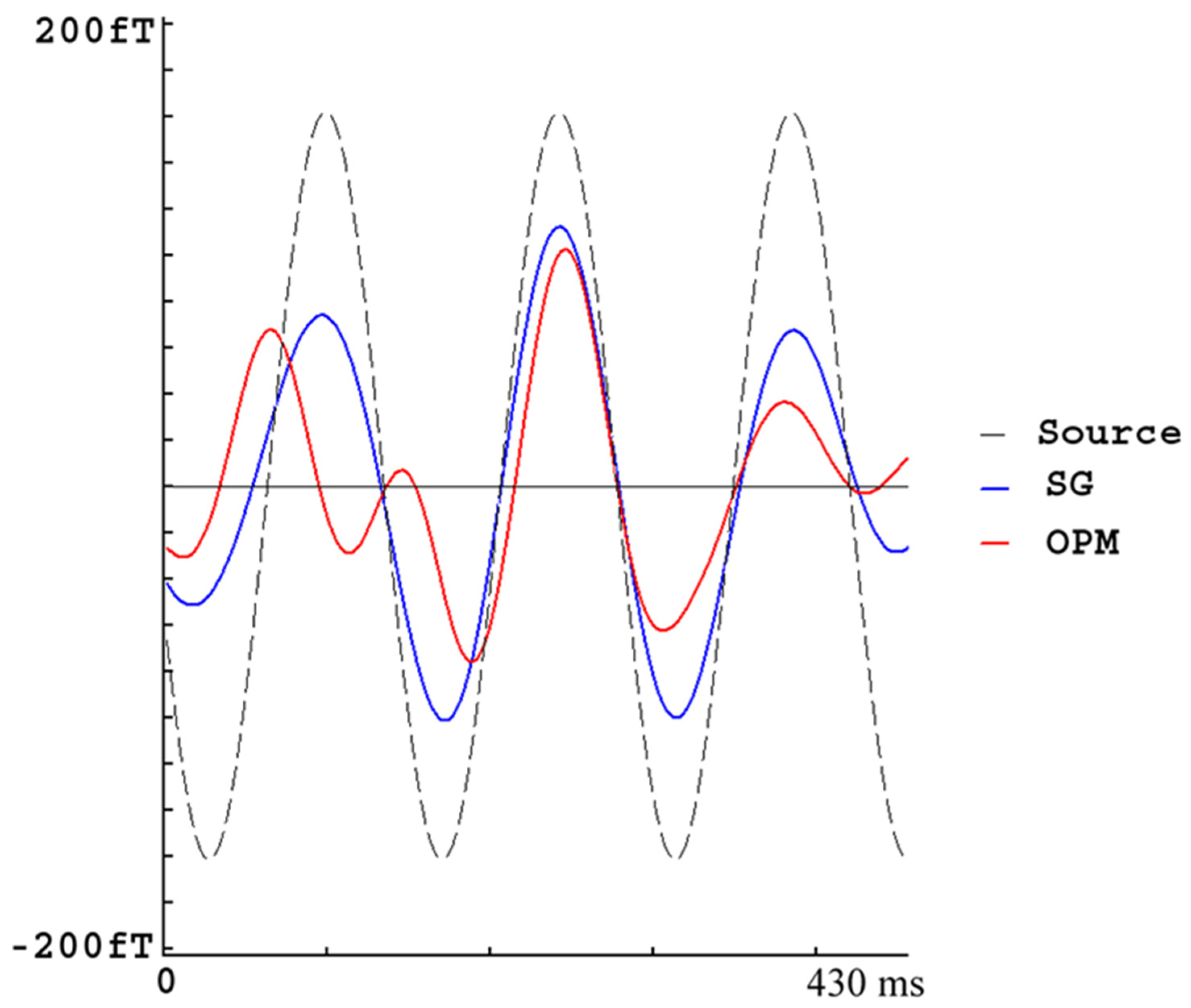
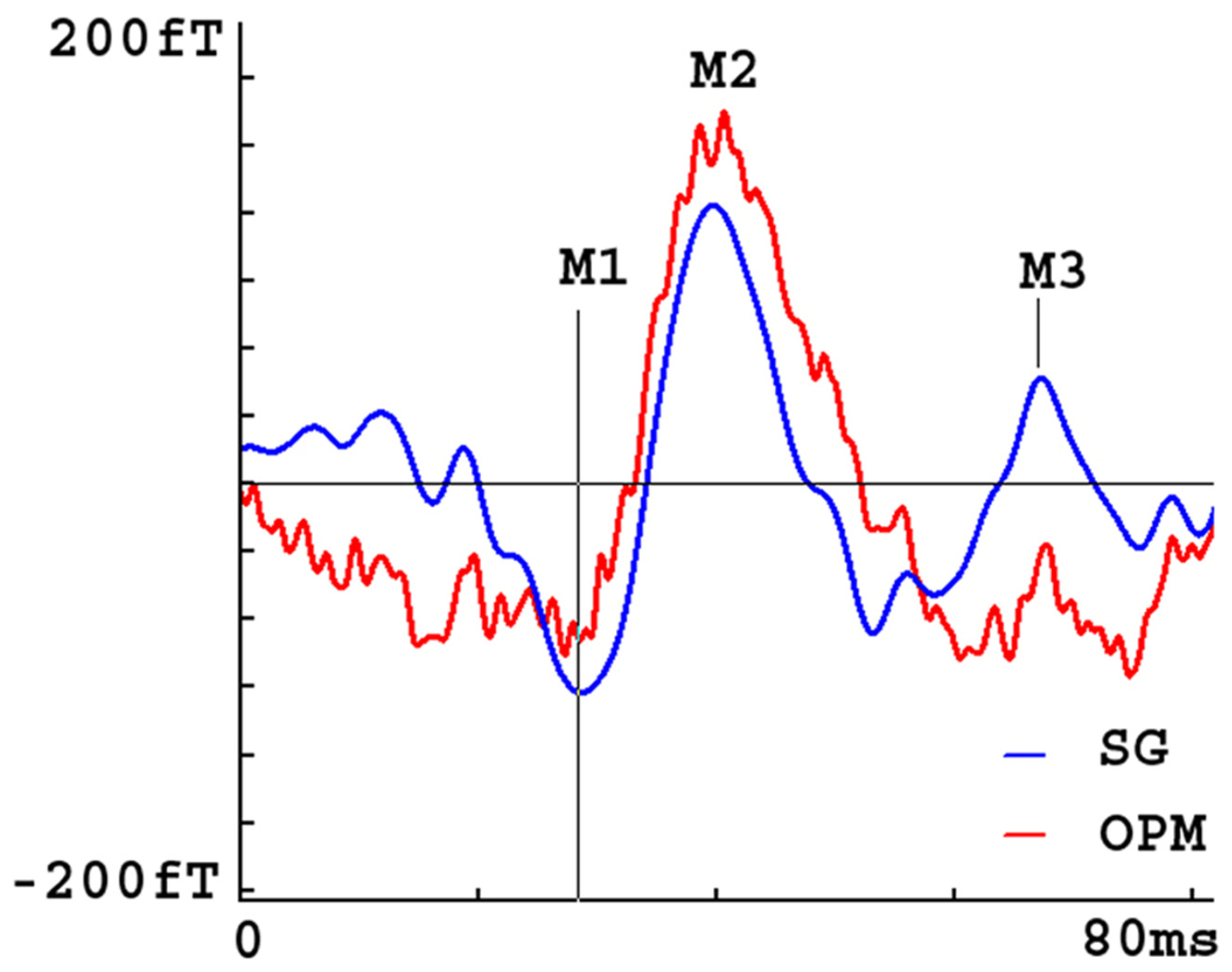
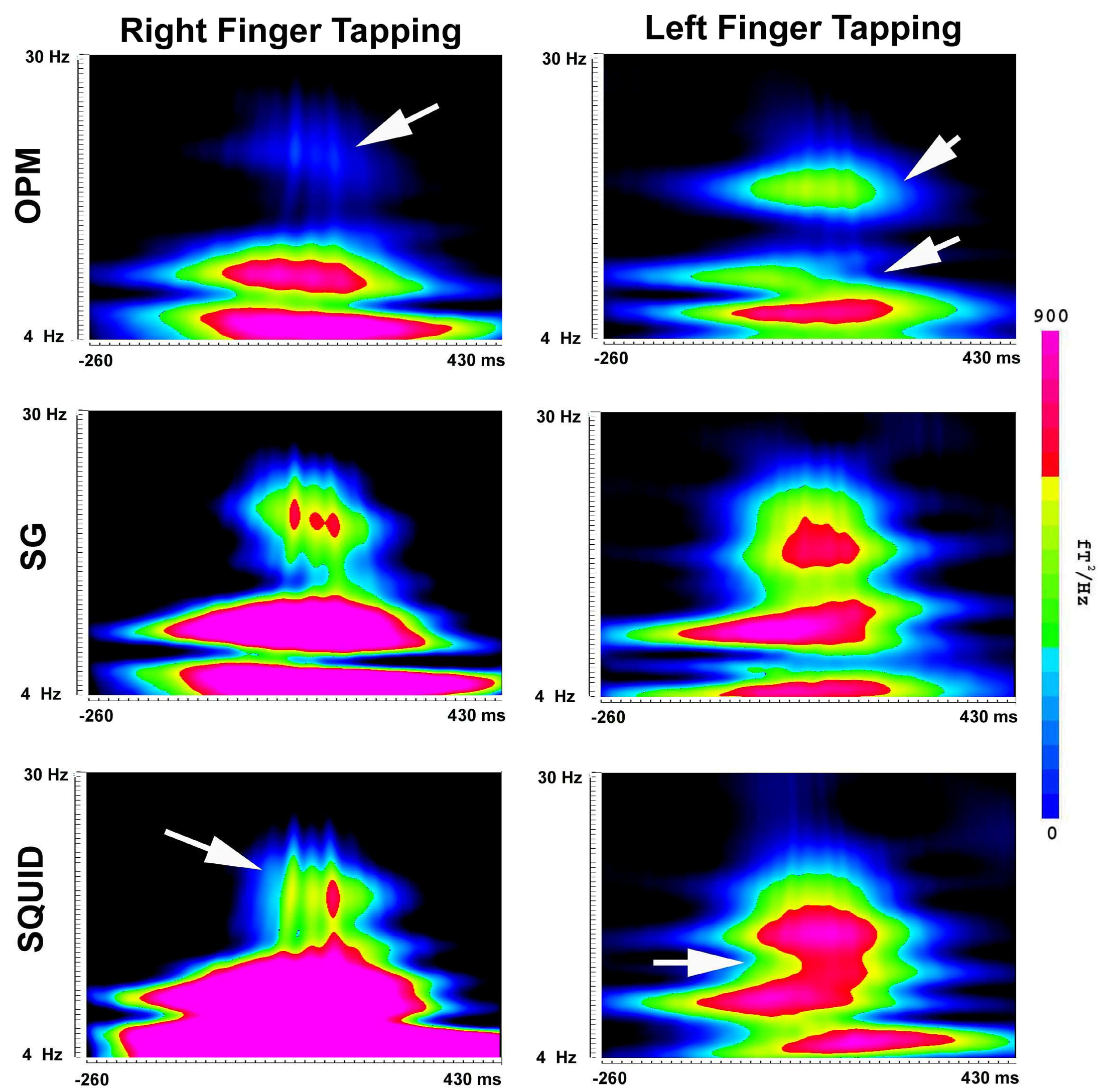
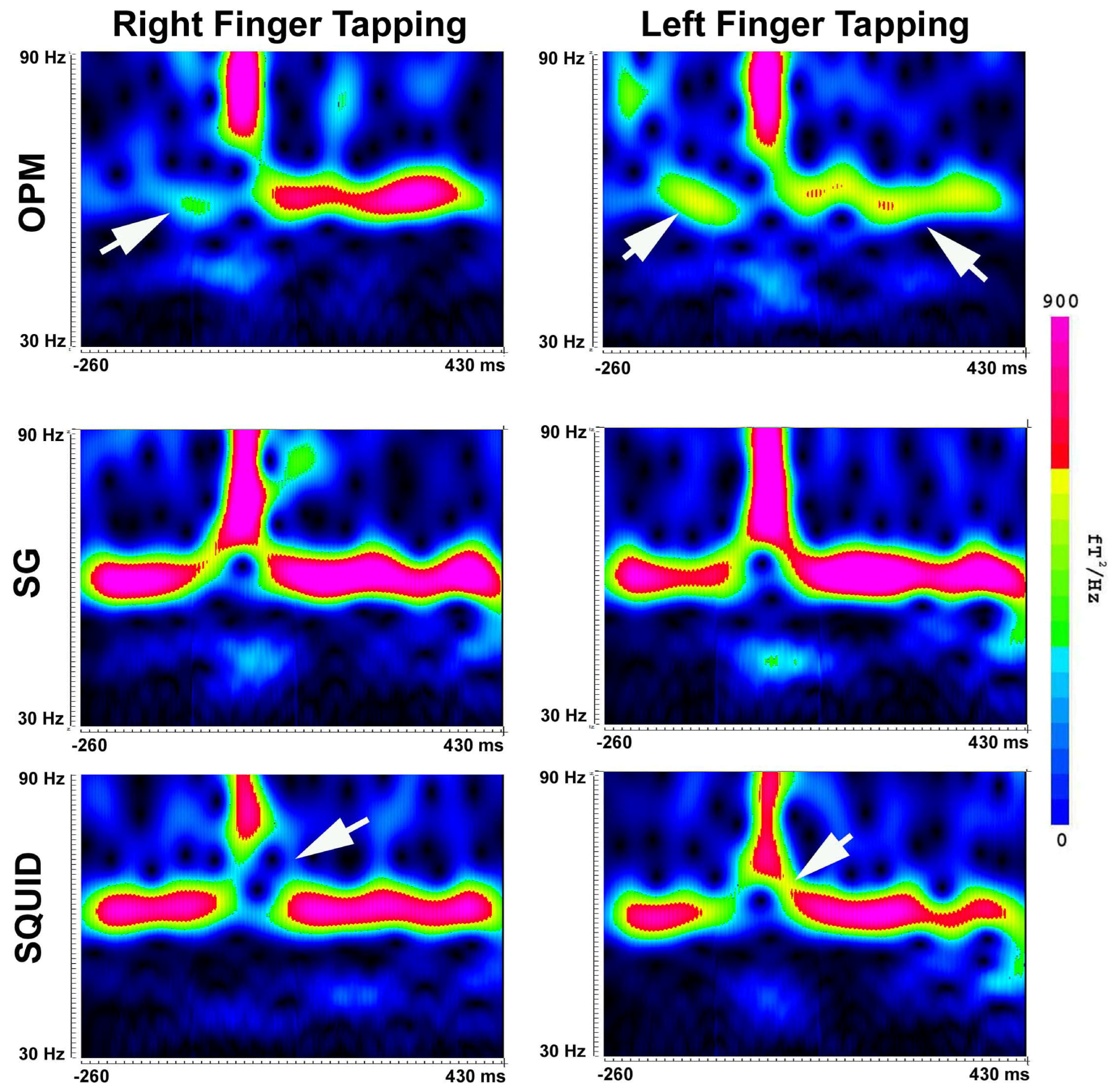
| Sensitivity (fT/Hz ½) | SNR | Temporal (ms) | Spatial (mm) | Brain Responses | |
|---|---|---|---|---|---|
| OPM | 15.7 | 4.318 | ~2.0 | 4.966 | 0.67 |
| SG | 9.3 | 6.915 | ~2.0 | 3.927 | 1.00 |
| PG | 15.4 | N/A | ~2.0 | N/A | N/A |
Disclaimer/Publisher’s Note: The statements, opinions and data contained in all publications are solely those of the individual author(s) and contributor(s) and not of MDPI and/or the editor(s). MDPI and/or the editor(s) disclaim responsibility for any injury to people or property resulting from any ideas, methods, instructions or products referred to in the content. |
© 2023 by the authors. Licensee MDPI, Basel, Switzerland. This article is an open access article distributed under the terms and conditions of the Creative Commons Attribution (CC BY) license (https://creativecommons.org/licenses/by/4.0/).
Share and Cite
Xiang, J.; Yu, X.; Bonnette, S.; Anand, M.; Riehm, C.D.; Schlink, B.; Diekfuss, J.A.; Myer, G.D.; Jiang, Y. Improved Biomagnetic Signal-To-Noise Ratio and Source Localization Using Optically Pumped Magnetometers with Synthetic Gradiometers. Brain Sci. 2023, 13, 663. https://doi.org/10.3390/brainsci13040663
Xiang J, Yu X, Bonnette S, Anand M, Riehm CD, Schlink B, Diekfuss JA, Myer GD, Jiang Y. Improved Biomagnetic Signal-To-Noise Ratio and Source Localization Using Optically Pumped Magnetometers with Synthetic Gradiometers. Brain Sciences. 2023; 13(4):663. https://doi.org/10.3390/brainsci13040663
Chicago/Turabian StyleXiang, Jing, Xiaoqian Yu, Scott Bonnette, Manish Anand, Christopher D. Riehm, Bryan Schlink, Jed A. Diekfuss, Gregory D. Myer, and Yang Jiang. 2023. "Improved Biomagnetic Signal-To-Noise Ratio and Source Localization Using Optically Pumped Magnetometers with Synthetic Gradiometers" Brain Sciences 13, no. 4: 663. https://doi.org/10.3390/brainsci13040663
APA StyleXiang, J., Yu, X., Bonnette, S., Anand, M., Riehm, C. D., Schlink, B., Diekfuss, J. A., Myer, G. D., & Jiang, Y. (2023). Improved Biomagnetic Signal-To-Noise Ratio and Source Localization Using Optically Pumped Magnetometers with Synthetic Gradiometers. Brain Sciences, 13(4), 663. https://doi.org/10.3390/brainsci13040663








